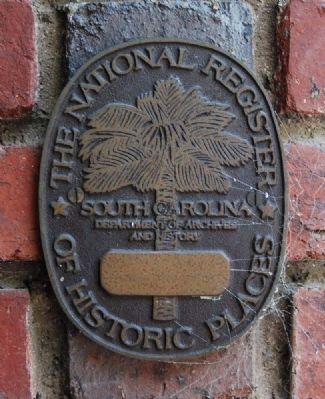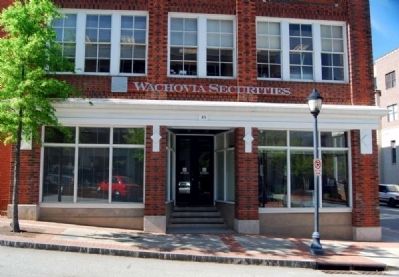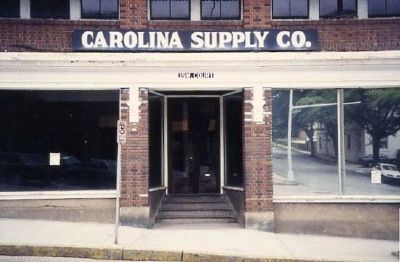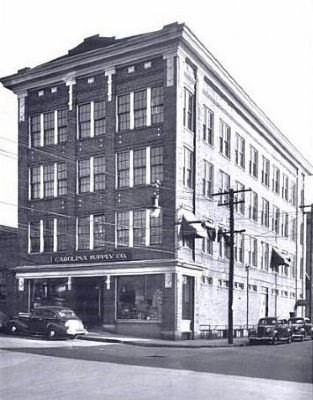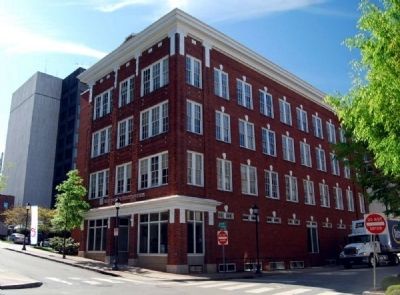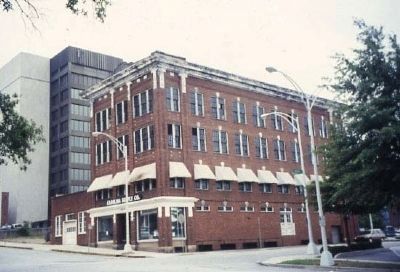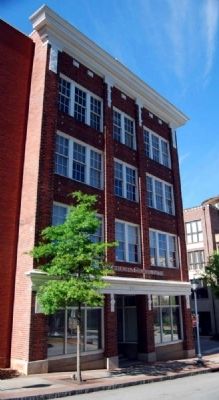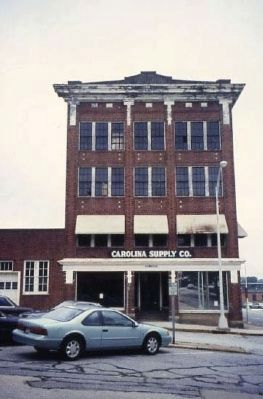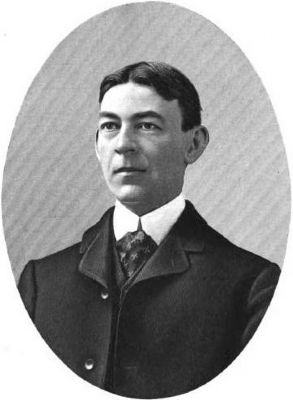Greenville in Greenville County, South Carolina — The American South (South Atlantic)
Carolina Supply Company
of Historic Places:
Carolina Supply
Company
Erected 1997 by Carolina Holdings, Inc.
Topics. This historical marker is listed in this topic list: Notable Buildings.
Location. 34° 50.917′ N, 82° 24.067′ W. Marker is in Greenville, South Carolina, in Greenville County. Marker is at the intersection of West Court Street and South Laurens Street, on the right when traveling east on West Court Street. Marker is located near the north entrance. Touch for map. Marker is at or near this postal address: 35 West Court Street, Greenville SC 29601, United States of America. Touch for directions.
Other nearby markers. At least 10 other markers are within walking distance of this marker. Greenville County Courthouse / The Willie Earle Lynching Trial (within shouting distance of this marker); Joel Roberts Poinsett (about 300 feet away, measured in a direct line); Spirit of Freedom (about 300 feet away); City of Greenville 9-11 Plaque (about 300 feet away); a different marker also named Joel Roberts Poinsett (about 400 feet away); Huguenot Mill Office (about 400 feet away); Vardry McBee (about 400 feet away); Poinsett's Spring (about 400 feet away); Chamber of Commerce Building (about 400 feet away); The Old Record Building (about 400 feet away). Touch for a list and map of all markers in Greenville.
Also see . . .
1. Carolina Supply Company. The Carolina Supply Company Building is one of Greenville’s most important architectural and historical landmarks. (Submitted on May 1, 2010, by Brian Scott of Anderson, South Carolina.)
2. J. E. Sirrine Scholarship Program. Online brochure regarding the J.E. Sirrine Scholarship Program. (Submitted on May 1, 2010, by Brian Scott of Anderson, South Carolina.)
Additional commentary.
1. Carolina Supply Company - National Register Nomination Form
Building Type and Setting
The Carolina Supply Company Building is a four-story brick commercial structure constructed in 1914 at the corner of West Court Street and Jackson Street (now South Laurens Street) in Greenville, South Carolina. The building is a utilitarian Renaissance Revival design with more simple architectural elements than many of the surrounding historic buildings. The restrained detailing is nonetheless distinctive and representative example of a commercial building dating from the early twentieth century.
The building's location is within the central business district and is one block removed from South Main Street. The immediate area was considered to be the center of Greenville's business and government. There are four properties within the immediate vicinity that are listed in the National Register of Historic Places: the Poinsett Hotel (1925), directly across West Court Street and fronting South Main Street; the former Greenville County Courthouse (1916) also located on South Main Street; Downtown Baptist Church (1857) on West McBee Avenue; and the Huguenot Mill Office (1895) on East Broad Street at the Reedy River just to the south. The site has relatively level topography with the existing improvements of the Carolina Supply Company Building and a concrete slab abutting the building. This was the former location of a two-story building that was also owned by Carolina Supply Company but was previously demolished. The orientation of the building is to the north with the main entrance facing West Court Street. A railroad spur was formerly adjacent to the rear of the building that is now a parking lot.
The building is largely unaltered with the primary structure in good condition.
General Characteristics
The Carolina Supply Company Building has a total of 20,000 square feet with four 4,000-square foot floors and a basement. The symmetrical design has three bays on the front facade with a flat roof. The building is also characterized by the red brick exterior with distinctive but selective detailing. The structural integrity of the building is substantial with a foundation floor constructed of a 13" reinforced concrete pad while the upper floors are 8" concrete slabs. Windows are typically paired or grouped with six-over-six or eight-over-eight wood sash.
Special Features - Exterior
The building retains its original storefront with a prominent metal cornice on the first floor above the storefront. A second cornice is located below the stepped parapet. The front facade windows are triple six-over-six wood sash windows on the outside bays and paired six-over-six sash windows within the middle bay. The western elevation windows on the second, third and fourth floors are also six-over-six sash windows capped by flat arches with keystones. The rear elevation features large, segmented arched windows with eight-over-eight panes.
The masonry detailing includes the use of common bonds to create the appearance of masonry panels with inset terra cotta tiles. This detailing is located between the upper floors on the front facade. A masonry corbel is located on the fourth floor providing a stepped projection beneath the cornice. Decorative metal trimmings with "diamond" (lozenge) detailing are prominently located on the front facade and also on the western elevation pilasters on the second and fourth floors just below the cornices.
The main entrance is recessed with a patterned mosaic tile floor and a molded pressed copper ceiling over a double-leaf front door. The original sign board is still intact above the storefront cornice. The rear of the building has a concrete loading dock with corrugated iron siding and a shed roof.
Special Features - Interior
The interior is characterized by limited ornamentation primarily due to the nature of the company business. Notable features are the exposed masonry walls and four "mushroom" shaped columns for vertical support. The columns range in diameter from 24" at basement level to 16" on the fourth floor. One inch maple tongue-and-groove flooring with a pine plank subflooring is still intact in limited areas of the first and second floor.
The floor plan is open with floor widths of forty feet and depths of one hundred feet. Adjacent to the west wall is an open stairway of reinforced concrete providing access to all floors. An elevator, by Park Manufacturing Company of Charlotte, is located at the rear of all floors. The elevator drive mechanisms are still intact. A skylight, of reinforced wire glass, tops the elevator shaft. Limited plumbing facilities remain within the building with a first-floor bathroom beneath the stairwell.
Alterations
The Carolina Supply Company Building is generally unaltered with only limited modifications. A one-story addition was constructed on the east wall of the building sometime prior to 1944. The masonry closely resembles the primary building's masonry. It appears that the addition was built shortly after the completion of the primary building. The front facade of the addition is dominated by a large, wooden, roll-up door that is flanked with paired, four-over-four pane windows. A transom tops the roll-up door. A standing seam roof covers the addition with a stepped parapet wall. An adjacent two-story structure was acquired by the company in the 1940s and served as additional office and storage space. This annex was demolished by the city in 1987 due to structural problems.
Metal window awnings were added to the second floor windows between 1944 and 1960 according to documentary photographs.
The interior of the building also has only limited alterations. The first floor shelving and second floor offices were previously removed and the floor space is largely open. Some of the second floor has vinyl tiles in areas where offices were formerly located. A small bathroom was formerly located on the second floor adjacent to the stairway and has been removed. The company safe, also located on the second floor, was removed and the masonry room housing the safe is now open.
A HVAC system was installed in recent years to service the first floor and electrical conduit is located along the ceilings and some walls.
Deterioration
Vacant since 1990, the building has incurred only limited deterioration.
The one-story addition has suffered from moisture problems and termite damage. Some roof timbers are rotted and the moisture penetration is evident on the masonry within this addition.
The rear loading dock has cracked concrete in some areas and the metal shed roof over the dock is damaged.
Significance
The Carolina Supply Company Building is one of Greenville's most important architectural and historical landmarks and is eligible for listing in the National Register of Historic Places under Criteria A and C. The former textile supply structure is an outstanding example of a commercial building designed in the utilitarian Renaissance Revival style, and is also significant for its integral role in the evolution of the textile industry in upstate South Carolina.
Commerce
The Carolina Supply Company was incorporated in July 1899 as a textile and industrial supply company for the purpose of supplying mills with equipment and supplies. The initial capital infusion of $25,000 was provided by F.J. Pelzer of Charleston, Thomas Inglesby, Francis Cogswell and D.G. Morton, who became the first president.
By the late nineteenth century, the textile industry was the dominant business within Greenville's economy. The city became known as a leading textile center with major mills such as Woodside, Monaghan, Orr Cotton Mills, Dunean and F.W. Poe Manufacturing Company. The growth of the textile business in and around Greenville created an overwhelming demand for a mill supply house that could furnish nearby plants with equipment and supplies. As the textile industry flourished and Greenville's economy prospered, the Carolina Supply Company outgrew its first two locations at 218 Pendleton Street and the corner of West Washington Avenue and Laurens Street. The company's inventory rapidly expanded, and it offered, according to its 1911 catalogue, a wide range of merchandise including "Cotton Mill Furnishings Together With Machinery, Pumps, Tools, and A Full line of General Mill Supplies." The company's trademark was "Squaredeal" which was prominently shown on the company's catalogues in 1906 and 1944. According to the photographs in the catalogues, merchandise was displayed on plain wooden shelves with an extensive inventory. The company also enjoyed a substantial mail-order business in addition to telephone and walk-in sales. With the successful growth of the company, the owners purchased a lot in 1910 at the southeastern intersection of West Court Street and South Jackson Street (known today as Laurens Street). The immediate area was one of Greenville's fastest growing commercial areas, with close proximity to railroad tracks and major mills
such as the neighboring Camperdown Mills. Also located nearby was the Mansion Hotel, one of the area's finest hotels, and the Record Building, Greenville's courthouse and center of local government affairs.
Carolina Supply's association with the textile industry led to a natural business relationship with Joseph Emory Sirrine, the region's leading mill architect and engineer residing in Greenville. Subsequently, J.E. Sirrine and Company was hired to design a new building for Carolina Supply Company. The design phase commenced in 1913 with plans and drawings overseen by John A. McPherson of the Sirrine firm.
The construction of the Carolina Supply Company Building was completed in 1914 and the company continued to see increased sales with the growing prosperity of the region's textile industry. By 1925, the company employed over twenty people with Thomas S. Inglesby as president and treasurer, and Francis J.P. Cogswell as assistant treasurer and secretary. The Inglesby family maintained a strong association with the company throughout its existence. Thomas S. Inglesby, Jr. started his employment with the company in 1928 following in the footsteps of his father. Initially a salesman with the firm, he was later promoted to clerk and became secretary and treasurer in 1937 and president shortly thereafter. He held this position until his retirement in 1985. His wife, Ann, worked as a secretary for the company, and a son, Francis J. Inglesby, became a vice president and general manager in 1980. Francis Inglesby managed the company until its sale in 1990 to Greenville Textile Supply Company. Being largely dependant upon the textile industry, the company's success closely followed the prosperity of the region's textile mills. During the depression, Carolina Supply Company was fortunate to have an inventory of steel machine parts that were scarce in the region. Thomas S. Inglesby maintained pre-depression prices adhering to the company's trademark, "Squaredeal", but only selling the desired parts to those customers that had an established relationship with the company. By the outbreak of World War Two, the company was one of the leading textile supply firms in the South. Some of the largest customers were Regal Textile in Ware Shoals, Springs Mill in Lancaster, South Carolina, and Clinchfield Mill in Marion, North Carolina. Salesmen and customers from out of town stayed at the elegant Poinsett Hotel located across Court Street from the Carolina Supply Company Building. Textile items such as the "Atlas Emery Fillet", were acquired from England for resale by the company. Large quantities of items such as loom bolts and nuts were obtained from the William A. Haskell Company and delivered by the railroad in carload shipments directly to the rear of the building.
During the life of the Carolina Supply Company, the textile industry was the dominant business driving the economy of Greenville County. By 1920, Greenville County had twenty-two textile mills employing 8,478 people and a capital investment of $20,207,801. The value of the annual production of goods from Greenville's textile establishments was $47,106,642, ranking the county first in the state that year. Throughout this decade, the local textile industry experienced unparalleled growth and according to a 1926 United States Department of Commerce General Bulletin, Greenville County was ranked seventh in the United States in textile production. Closely aligned with most of the major textile mills in the region, Carolina Supply company was one of the South's leading mill supply firms by this time. As a result, the company was stable and economically viable and became one of Greenville's best known businesses. The Carolina Supply Company was a major contributor to the success of the region's textile industry and played a significant role in Greenville's history.
Architecture
The Carolina Supply Company Building is an outstanding example of a utilitarian retail and warehouse structure from the early part of this century. More simple in design than the city's Victorian era commercial buildings, the building is representative of the Academic Classical movement of the time. Although J.E. Sirrine relied on functionalism for the basic design theme, he used disciplined ornamentation with selective Renaissance Revival detailing that was characteristic of commercial architecture during this period. This design philosophy incorporated distinctively restrained and sophisticated re-handling of architectural elements derived from earlier styles. The restrained adaptation of classical elements with the cornice treatments, flat window arches with keystones and segmented window arches reflect this design influence. The functional design of the building served the retail, administrative and storage needs of the company well during its existence. The crisp architectural detailing on the front facade, with the prominent cornice above the storefront, draws attention to the display windows of the storefront which featured displayed merchandise. The front and western elevations have the greatest exposure from adjacent streets and the architectural detailing was emphasized on these facades. As the company attracted retail traffic for walk-in sales as well as mail-order business, the design made the building distinctive thus promoting this aspect of the company's retail business.
J.E. Sirrine is considered to be one of the most important industrial architects and engineers to practice in South Carolina. His work spanned five decades and included projects as far away as Texas and Maine. Perhaps more than any other architect, Sirrine was responsible for shaping the design and structural principles of the emerging industrial complexes of upstate South Carolina. He designed a number of well-known structures in his hometown of Greenville including Textile Hall (1916 - now demolished), Woodside Mills (1909), Dunean Mills (1923), Poinsett Hotel (1924) and a number of school buildings including the main dormitory and dining room building (1920--now demolished) at his alma mater Furman University.
Sirrine was educated locally at the Greenville Military Institute and Furman University, where he received a B.S. degree in 1890. His professional career started as a civil engineer and he joined Lockwood, Greene & Company of Spartanburg in 1895 as surveyor for the new F.W. Poe Textile Mill. In 1898, Sirrine was named manager of Lockwood Greene's new southern regional office in Greenville with authority over projects in Georgia and the Carolinas. Sirrine was in a position to become an equal partner but left the firm to open his own office in Greenville in 1903. In 1921, Sirrine formed a partnership with eight of his associates, called J.E. Sirrine & Company, Engineers. In addition to his high profile commercial commissions, Sirrine accepted a number of other design assignments that included over 1600 textile mill village houses, churches, hospitals, clubhouses for country clubs and single-family residences.
Sirrine revolutionized the textile industry in the South with his design innovations. He recognized the need to convert from water power and steam-driven operations to electrical power by the turn of the century. He also advocated the use of reinforced concrete at a time when the commonly accepted flooring material had been long leaf pine timber for industrial facilities. This alternative helped reduce the risk of fire and provided a more stable floor construction. This also help alleviate future problems with sagging floors thus avoiding unevenly-seated machinery which might increase the strain on bearings. This emphasis on reinforced concrete is evident in the design of the Carolina Supply Company Building and a number of other Sirrine designed projects of the time. J.E. Sirrine also relied on the use of patterned brickwork and restrained neoclassical detailing that characterized his designs for many commercial structures. These design elements were also incorporated into other local landmarks designed by Sirrine, most notably Textile Hall, the Poinsett Hotel and Greenville High School. His legacy still survives with his successor company, Jacobs Sirrine, known as one of the leading engineering firms in the nation. His community contributions were also substantial with the J.E. Sirrine Textile Foundation providing assistance to enhance textile education at Clemson University and a trust fund for Greenville high school students that has provided more than $11 million in aid to over 3,000 students. When J.E. Sirrine died in 1947, the bells at Furman University tolled all day to honor his memory.
— Submitted May 1, 2010, by Brian Scott of Anderson, South Carolina.
2. Daniel Green Morton (1st President of Carolina Supply)
Daniel Green Morton, of Greenville, Greenville county, South Carolina, railroad engineer and railroad manager, was born in Richmond, Virginia, on the 5th of September, 1858. His father, Richard Morton, was a civil engineer in his early life; a man of clear mind, great gentleness of character, and exceptional integrity. His mother, Mrs. Mary Virginia (Green) Morton, was the daughter of Samuel Slaughter, of Culpeper, Virginia.
His early life was passed in Baltimore, Maryland. He had good health and was fond of out-of-door tasks; and he attended with faithfulness, and with interest in his studies, the public schools of Baltimore, completing the course in June, 1887. He studied civil engineering; and he began his work as an engineer in 1888, as rodman on the engineering corps of the old Richmond and Danville railroad, in Western North Carolina. From 1889 to 1891 he served as resident engineer of that railroad. From 1893 to 1896 he was supervisor of the track of the Baltimore and Ohio railroad, at Wilmington, Delaware. From 1896 to 1898 he was engaged as engineer and contractor on public work in and around Baltimore. Since July, 1899, he has been president of the Carolina Supply company, Greenville, South Carolina, which deals in cotton mill and factory supplies of all descriptions.
On the 17th of April, 1892, he married Miss Anne Louise Rose, daughter of Arthur Barnwell Rose, of Charleston, South Carolina. They have two children, both of whom are living in 1907.
Mr. Morton is a Democrat, on the tariff issue.
By religious conviction and training he is identified with the Protestant Episcopal church. His favorite forms of recreation are "reading for indoors, and golf for out-of-doors." (Source: Men of Mark in South Carolina: Ideals of American Life: A Collection of Biographies of Leading Men of the State, Volume 2 by James Calvin Hemphill (1908), pg 286.)
— Submitted May 1, 2010, by Brian Scott of Anderson, South Carolina.
3. Joseph Emory Sirrine
Joseph Emory Sirrine, civil engineer and engineer for industrial plants and water power development, was born in Americus, Sumter county, Georgia, December 9, 1872. His parents were George W. and Sarah E. Sirrine. His father was a carriage and wagon manufacturer, an energetic and public-spirited man, who was devoted to his family, and who, though never holding political office, was helpful in the community in which he lived. For many years he was president of the free public library of Greenville and also of the Hospital association of that town. The earliest ancestor in this country whose name is known was John Sirrine, who was born January 4, 1769. His father, whose name is not remembered, came from France and settled in Louisiana. John Sirrine was the great great-grandfather of the subject of this sketch. He died February 4, 1812. On the maternal side, the great-grandfather of Joseph Sirrine was John Rhinelander, the name afterward shortened to Rylander, who either settled or was born near Savannah, Georgia. His family came from the province of Salzburg, in Germany. His mother's maternal grandfather was Joseph Brown, who resided in the old Abbeville district, South Carolina.
In childhood and youth Joseph Sirrine was strong and well. His home was in the village of Greenville, and he was fond of outdoor life and was also deeply interested in machinery. Except while at school he had regular tasks to perform, and he believes that this was of great benefit, because it taught him the value of close application to the work in hand. There were no difficulties to overcome in his efforts to secure an education. He was fond of reading and study, and his mother exerted a strong influence on his intellectual life. Until he was thirteen years of age he attended public and private schools in Greenville. He then entered Furman university, where he remained three years, but, as he omitted the last year of the course, he was not graduated. In his boyhood he was especially fond of books of travel, but while at the university his time was largely given to the study of mathematics. From very early years he had desired to become a civil engineer, and to this choice there was no opposition on the part of his relatives or friends. The active work of his life was commenced in June, 1890, as a rodman on a railroad survey. From this time to 1895 he was engaged in the general work of a civil and a mill engineer. In the year last named he became associated with the firm of Lockwood, Greene & Company, of Boston, Massachusetts, as constructing engineer. He remained with this firm until 1902. During the last three years of this connection, a period of great activity in the erection of cotton mills in that section, he was manager and chief engineer in their Southern department. Foreseeing a great development in the manufacture of cotton in the South which would bring a large amount of business to men in his profession, he severed his connection with the Boston firm, and in 1902 began business under his own name as a mill engineer. The success which had attended his work had given him an excellent reputation, and when he opened an office in Greenville, in which he employed several assistants, his services were in great demand, and from that time to the present he has carried on a large business in planning industrial plants and in water power developments. Many of the larger manufacturing plants now in operation in his section of the state were constructed according to his plans and under his supervision. It is safe to say that he is recognized as the foremost mill engineer in South Carolina, and his reputation has extended far beyond the bounds of the state.
Of fraternal orders, Mr. Sirrine is a member of the York Rite Masons, and is a noble of the order of the Mystic Shrine; while of scientific bodies he is a member of the American Society of Civil Engineers and of the American Institute of Electrical Engineers. In politics he is a Democrat, although in 1896 and 1900 he refused to vote the national ticket on account of its advocacy of the free coinage of silver. He is a close student and a hard worker, but occasionally secures recreation out of doors in the common sports, while for indoor amusement he enjoys card games, especially whist.
In reply to a request for suggestions in regard to habits and principles which help young people to attain true success in life, he says: "Work without regard to purely temporary benefits will insure a fair degree of success to any man of average mind and good habits. Faithfulness and energy are the only things that can make success."
On November 8, 1898, Mr. Sirrine was married to Jane Pinckney Henry. Their home is Number 326 North Main street, Greenville, South Carolina. (Source: Men of Mark in South Carolina: Ideals of American Life: A Collection of Biographies of Leading Men of the State, Volume 2 by James Calvin Hemphill (1908), pgs 354-356.)
— Submitted May 1, 2010, by Brian Scott of Anderson, South Carolina.
4. National Register of Historic Places:
Carolina Supply Company (added 1997 - Building - #97000743)
• Historic Significance: Event,
• Architecture/Engineering
• Architect, builder, or engineer: Carter--Fiske Construction, Sirrine, J.E.
• Architectural Style: Renaissance
• Area of Significance: Commerce, Architecture
• Period of Significance: 1900-1924, 1925-1949
• Owner: Private
• Historic Function: Commerce/Trade
• Historic Sub-function: Business, Warehouse
— Submitted May 1, 2010, by Mike Stroud of Bluffton, South Carolina.
Credits. This page was last revised on April 18, 2021. It was originally submitted on May 1, 2010, by Brian Scott of Anderson, South Carolina. This page has been viewed 1,754 times since then and 48 times this year. Photos: 1, 2. submitted on May 1, 2010, by Brian Scott of Anderson, South Carolina. 3. submitted on October 24, 2010, by Brian Scott of Anderson, South Carolina. 4, 5. submitted on May 1, 2010, by Brian Scott of Anderson, South Carolina. 6. submitted on October 24, 2010, by Brian Scott of Anderson, South Carolina. 7. submitted on May 1, 2010, by Brian Scott of Anderson, South Carolina. 8. submitted on October 24, 2010, by Brian Scott of Anderson, South Carolina. 9. submitted on May 1, 2010, by Brian Scott of Anderson, South Carolina.
